When the COVID-19 pandemic invaded the U.S., hospitals had to restructure their facilities to handle the infectious patients and close down of all nonessential units such as elective surgery. Foodservice responded with innovative solutions to the new patient censuses, fewer retail foodservice customers and changing staffing needs. Healthcare leaders also dealt with donations, community contributions and staffing.
Donations and Community Contributions
The Ohio State University Wexner Medical Center’s incoming food donations included more than 10,000 meals and 70,000 snacks. “We were so pleased and honored by the generosity of our community, but logistically it was challenging,” says Julie Meddles, MS, RDN, LD, director of Nutrition Services at OSUWMC. “Once we formed a committee 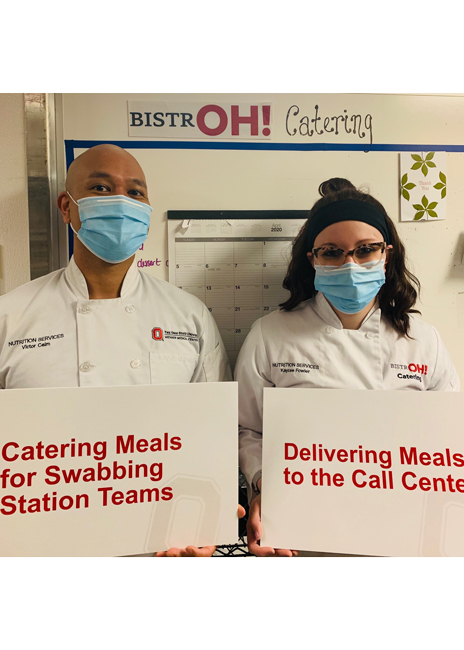 OSUWMC catering team members Victor Calm and Kaycee Fowler six-word "stories" of how they support caregivers during COVID-19.to include development, marketing, recognition and nutrition staff, the process went much better. But selfishly, we know it did cannibalize some of our lunch sales. We started offering more donated meals at dinner for staff to take home at the end of their shifts.”
OSUWMC catering team members Victor Calm and Kaycee Fowler six-word "stories" of how they support caregivers during COVID-19.to include development, marketing, recognition and nutrition staff, the process went much better. But selfishly, we know it did cannibalize some of our lunch sales. We started offering more donated meals at dinner for staff to take home at the end of their shifts.”
WellSpan Health received ample donations as well. “Not only did businesses retool some of their manufacturing to make face shields and masks and other personal protective equipment, some began to make hospital beds and other equipment to prepare for what was anticipated to be a huge influx of patients, especially since we are so close to New York, New Jersey, Philadelphia and other hot spots early on in the pandemic,” says Timothy F. Bentzel, DHCFA, senior director of Food and Nutrition Services, Legacy WellSpan Health in Pennsylvania. “Fortunately, we never experienced this increase, and we have been averaging around 50 COVID-19-positive patients a day across our health system of 8 hospitals in South Central Pennsylvania.”
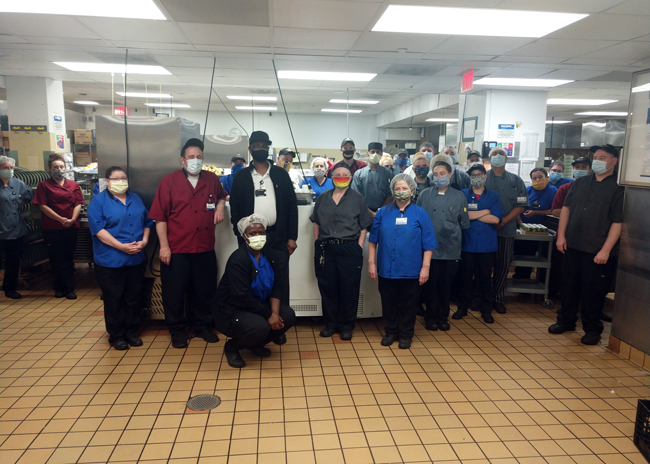 Staff at WellSpan York gather for a moment before reassessing their new responsibilities.
Staff at WellSpan York gather for a moment before reassessing their new responsibilities.
WellSpan’s hospitals received more than 240 donations through its website and nearly 100 donations across the system from community members who just dropped off  WellSpan staff at Bowmansville transport free packaged meals to staff, all of which were donated.donations at the local hospitals. One pizza shop in York created a financial support feature on its website and Facebook page for the community to send money. The company, in turn, sent pizzas to the hospital free of charge to all staff. “We received more than 1,000 pizzas from just this one mom and pop pizza shop,” Bentzel says. “This was an amazing outpouring of support.” All told, donations resulted in thousands of free meals to support staff across the system.
WellSpan staff at Bowmansville transport free packaged meals to staff, all of which were donated.donations at the local hospitals. One pizza shop in York created a financial support feature on its website and Facebook page for the community to send money. The company, in turn, sent pizzas to the hospital free of charge to all staff. “We received more than 1,000 pizzas from just this one mom and pop pizza shop,” Bentzel says. “This was an amazing outpouring of support.” All told, donations resulted in thousands of free meals to support staff across the system.
WellSpan received so many donations from community businesses and corporations that Bentzel enlisted the help of the WellSpan Health Foundation and the philanthropic, public relations and marketing teams to help coordinate these donations and send out thank you notes and acknowledgements.
Many hospitals also made food donations to local organizations. At OSUWMC, Meddles’ department continues to make donations to mid-Ohio food banks. They also partnered with Mid-Ohio Food Collective and converted the James Mobile Education Kitchen, which supports the community with culinary and nutrition education, into a mobile food bank that travels to sites where people with food insecurity could receive food, snacks and nutrition education.
Hendricks Regional Health’s Meals on Wheels program swelled during the spring to deliver 130 meals a day. The team headed by Martha J Rardin, MS, RDN, CD, FAND,  Sam Carter cooks breakfast menu items. Photo by Martha Rardindirector of Nutrition and Dietetics and the diabetes coordinator at Hendricks Regional Health, changed the delivery procedure. Wherever a delivery vehicle stopped, a cooler had to be outside so staff could place meals in the coolers rather than physically hand the meals to clients. Each day the staff wipe down each container and lid. The hospital’s foundation department received so many community donations they funded more than $40,000 in complimentary meals for associates.
Sam Carter cooks breakfast menu items. Photo by Martha Rardindirector of Nutrition and Dietetics and the diabetes coordinator at Hendricks Regional Health, changed the delivery procedure. Wherever a delivery vehicle stopped, a cooler had to be outside so staff could place meals in the coolers rather than physically hand the meals to clients. Each day the staff wipe down each container and lid. The hospital’s foundation department received so many community donations they funded more than $40,000 in complimentary meals for associates.
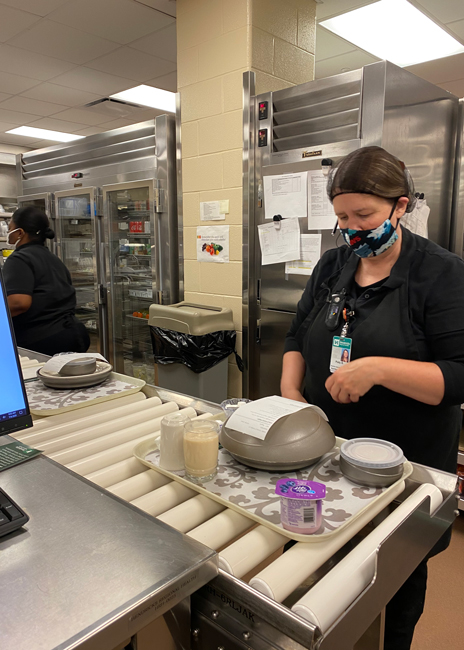 Polly Blevins expedites at the trayline to be sure the order is filled properly. Photo by Martha RardinHunterdon Medical Center received donations from the second week in March until the first week in June. “The great outpouring of support – more than 16,000 meals —came from many local restaurants, groups and families,” says Angela O’Neill, RD, director of Nutrition Services. The medical center’s foundation organized this process. Two reassigned staff members (back from furlough) worked on-site to coordinate arrival and distribution of meals and other donations such as masks, Girl Scout cookies, caps and bands to help protect ears. The donations cut into retail revenue a bit, yet, O’Neill says, “This allowed frontline heroes to stay in their units to get their nourishment.”
Polly Blevins expedites at the trayline to be sure the order is filled properly. Photo by Martha RardinHunterdon Medical Center received donations from the second week in March until the first week in June. “The great outpouring of support – more than 16,000 meals —came from many local restaurants, groups and families,” says Angela O’Neill, RD, director of Nutrition Services. The medical center’s foundation organized this process. Two reassigned staff members (back from furlough) worked on-site to coordinate arrival and distribution of meals and other donations such as masks, Girl Scout cookies, caps and bands to help protect ears. The donations cut into retail revenue a bit, yet, O’Neill says, “This allowed frontline heroes to stay in their units to get their nourishment.”
Hunterdon ordered a large pandemic supply of food and will donate some of the food to a local food bank.
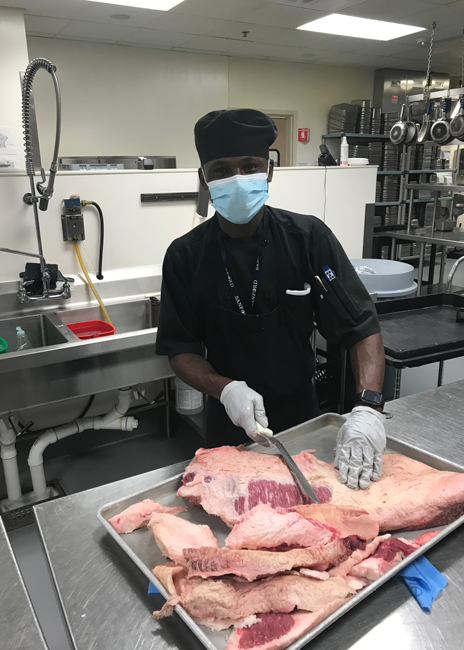 Emmanuel Gooknuh carves meat in SMCF production kitchen. Photo by Rusty Galloway.Three Sanford medical centers in Fargo, N.D., also received numerous donations from community and area businesses. “Most of the donations were meals and PPE,” says Lisa Gibson, MBAM, senior director of Support Services, Sanford Medical Center, Fargo, N.D. “Once Incident Command Center determined how the items were to be distributed throughout the medical center, we followed that plan.” Also, the medical centers provided local shelters with surplus food, such as soup, from the central kitchen that were produced but not served.
Emmanuel Gooknuh carves meat in SMCF production kitchen. Photo by Rusty Galloway.Three Sanford medical centers in Fargo, N.D., also received numerous donations from community and area businesses. “Most of the donations were meals and PPE,” says Lisa Gibson, MBAM, senior director of Support Services, Sanford Medical Center, Fargo, N.D. “Once Incident Command Center determined how the items were to be distributed throughout the medical center, we followed that plan.” Also, the medical centers provided local shelters with surplus food, such as soup, from the central kitchen that were produced but not served.
Staffing and People Concerns
Staffing challenges vary greatly at hospitals. Many have implemented layoffs and furloughs, while others reassigned employees to other jobs within the hospital. Some must encourage staff to return even though unemployment benefits are greater than their weekly pay and some have offered counseling to employees who are hesitant to return to an environment that is high-risk for contamination.
“Due to the financial impact of COVID-19, we’ll be seeing labor reductions, eliminating any overtime and holding some vacant positions,” Meddles says. “At OSUWMC, it’s a hiring ‘frost,’ not quite a freeze because we are posting needed positions, but with more scrutiny and justification.”
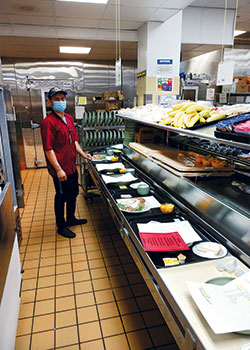 WellSpan York's traylineWellSpan utilized redeployed staff from other departments to assist with cleaning the cafeteria and dining rooms and wrapping silverware to allow foodservice staff to be more productive with food prep and more diligent in processing patient trays and cleaning and sanitizing patient food carts.
WellSpan York's traylineWellSpan utilized redeployed staff from other departments to assist with cleaning the cafeteria and dining rooms and wrapping silverware to allow foodservice staff to be more productive with food prep and more diligent in processing patient trays and cleaning and sanitizing patient food carts.
In addition, staff were concerned for their safety. “There were a lot of unknowns and uncertainty surrounding the coronavirus, for example how many patients would be admitted to the hospital, and how safe was the staff when handling contaminated tray ware and dirty food trucks,” Bentzel says. “Therefore, we worked with the staff to educate them, provide them with all the personal protective equipment necessary to protect them and reassured them we were doing everything possible to keep them safe.”
Bentzel and his team also knew that they were not the only staff that was afraid and anxious, so they tried to lift the spirits of others coming to the cafeteria. They not only provided all the free food that was donated to staff by the community but also presented some fun theme days such as Cinco de Mayo and provided free treats on numerous food-themed days such as national peach cobbler day, national pineapple upside down cake day and national chocolate chip cookie day. “We even coordinated a candy-gram across the system from the WellSpan Health Board of Directors.”
If large numbers of hospital staff continue to work from home, Bill Marks, director, Food, Nutrition and Environmental Services at Hennepin Healthcare, expects less need for labor. “We won’t replace staff members who retire, but rather we’ll trim down through attrition,” he says.
During the worst part of the pandemic, some Hennepin employees were asked to take paid time off because there wasn’t enough work for them to do. In May, when the hospital’s financial analysts projected enormous revenue losses, many departments had to furlough staff, although his Environmental Department was one of the few that did not due to increased cleaning requirements. Marks had to furlough up to 20% of his Food and Nutrition staff until the hospital brought in more patients and more staff returned to work. Furloughs are much lower now. However, all director level positions and above must furlough for one or two weeks before the year’s end.
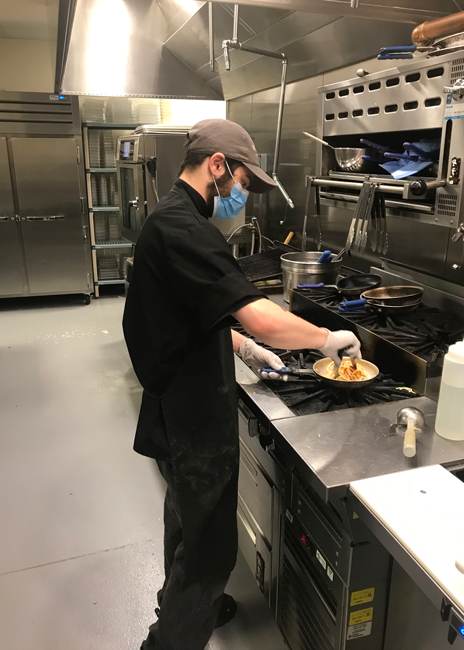 Spencer Franek prepares menu items on the room service cookline at Sanford Medical Center. Photo by Rusty Galloway Sanford Medical Center reduced many retail restaurants’ operating hours. “Many staff are taking low-need, low-census hours until we are able to reopen restaurants,” Gibson says. Very few of her staff had to be out due to illness. Today, everyone is required to take and document their temperatures and wear surgical masks while in the hospital.
Spencer Franek prepares menu items on the room service cookline at Sanford Medical Center. Photo by Rusty Galloway Sanford Medical Center reduced many retail restaurants’ operating hours. “Many staff are taking low-need, low-census hours until we are able to reopen restaurants,” Gibson says. Very few of her staff had to be out due to illness. Today, everyone is required to take and document their temperatures and wear surgical masks while in the hospital.
Gibson and her managers provide candy, meals and product giveaways as Thank Yous for staff members’ dedication.
Several staff members in Rardin’s department at Hendricks Regional Health, were scared and afraid to work in a hospital. “Their spouses and families were afraid they would bring ‘it’ home and infect everyone else. Three staff members talked about quitting to avoid working in a hospital, but none did. “We had to do a lot of hand holding and reassuring that the hospital was one of the safest places they could be with the issues PPE and cleaning procedures and that we are doing everything we can to keep them safe,” Rardin says.
She adds that “this is a necessary part of management, but it took a toll on our associates and also on management to deal with this on top of all the other uncertainties that were swirling at the time.”
Rardin and managers at Hendricks Regional Health thanked employees by offering them a free lunch once a week and bringing in donuts and free coffee. “We really stepped up the recognition of their dedication in our twice-a-day staff huddles,” she says. “We talked about how we are essential employees and it is a privilege to serve our community when our community needs us like never before.”
At Hunterdon, says O’Neill, a wellness cafe staff member who was full time was reassigned in the labor pool to accept donations and is now performing screening at the medical center’s entrances because the center has not reopened due to New Jersey restrictions on gym openings.
For more on Healthcare Foodservice during the COVID-19 pandemic, check out the FE&S Healthcare Foodservice Special Report.




